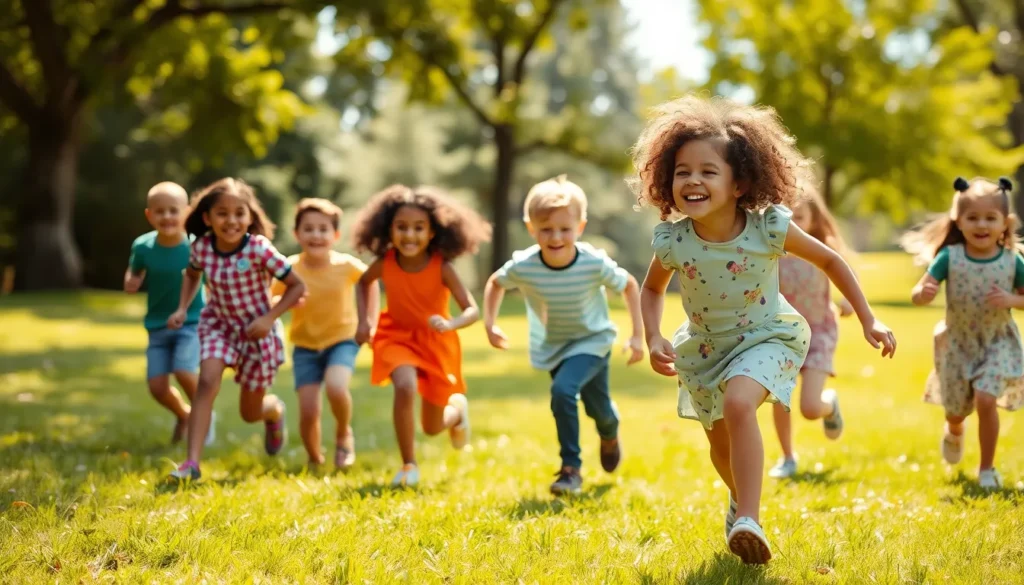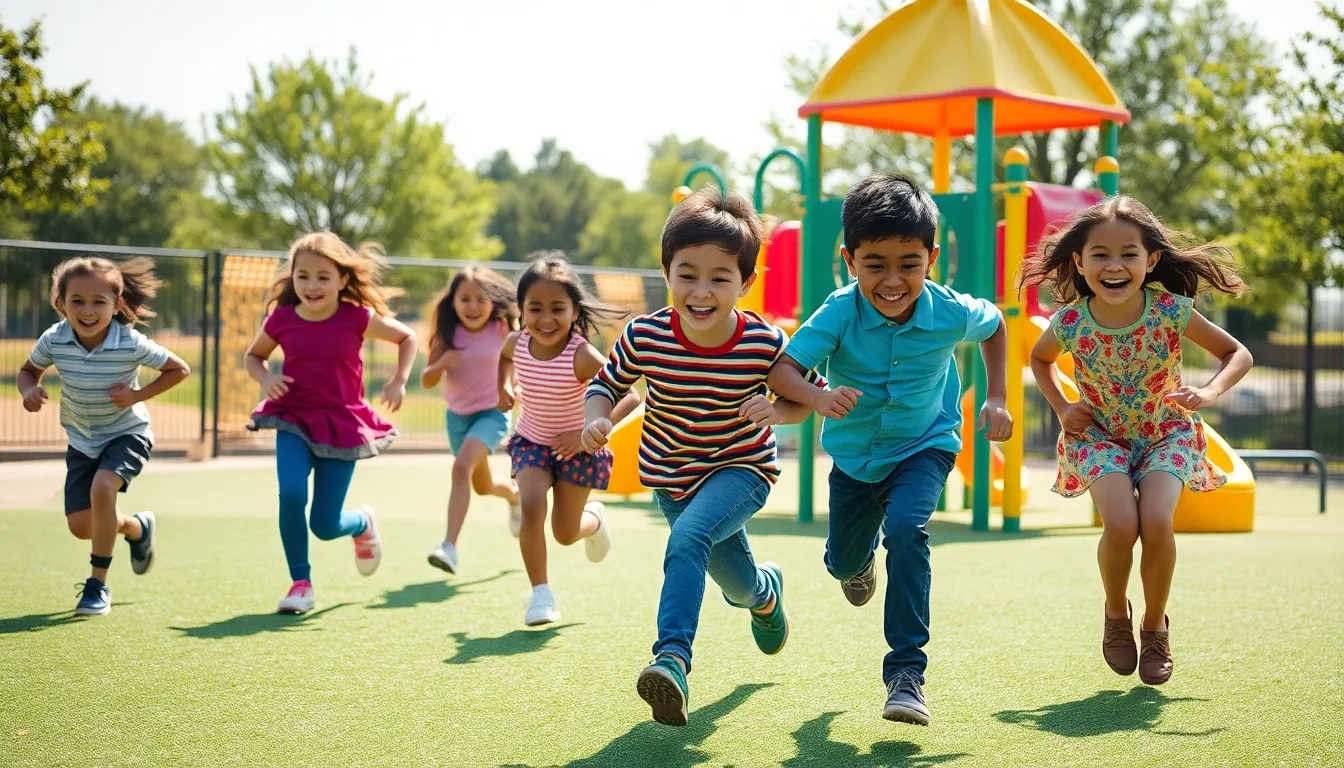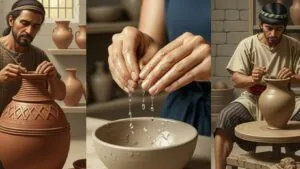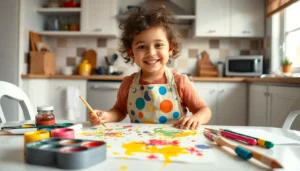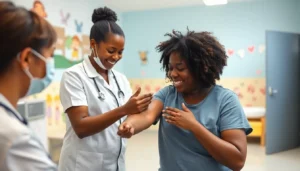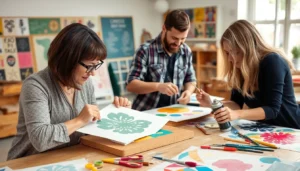Table of Contents
ToggleWhen it comes to keeping kids active and entertained, gross motor games are the unsung heroes of playtime. Forget about the latest video game or the fanciest gadget; nothing beats the joy of running, jumping, and tumbling around. These games not only get kids moving but also help develop essential skills like coordination and balance. Plus, they’re a fantastic way to burn off that seemingly endless energy.
Understanding Gross Motor Skills
Gross motor skills encompass the larger movements of the entire body, particularly those involving the arms, legs, and core. Developing these skills is essential for daily activities and overall physical health.
Definition of Gross Motor Skills
Gross motor skills refer to the abilities required for coordinated movement and physical activity. These skills include walking, running, jumping, climbing, and balancing. They utilize the large muscle groups in a child’s body. Mastering these movements lays a foundation for more complex physical tasks later on.
Importance of Gross Motor Skills Development
Developing gross motor skills contributes to numerous aspects of a child’s growth. Strong gross motor skills support confidence in physical activities and promote social interaction through group play. Coordination and balance gained from these activities reduce the risk of injury. Additionally, regular engagement in gross motor activities fosters cardiovascular fitness and encourages overall wellness.
Types of Gross Motor Games
Gross motor games fall into two main categories: outdoor and indoor activities. Each type plays a significant role in promoting physical activity and skill development in children.
Outdoor Gross Motor Games
Outdoor gross motor games often encourage children to explore their surroundings. Tag is a popular choice, requiring running and dodging. Relay races promote teamwork while developing speed and coordination. Obstacle courses offer a fun way to enhance problem-solving skills and physical agility. Hiking introduces kids to nature, allowing them to improve stamina and balance simultaneously.
Indoor Gross Motor Games
Indoor gross motor games provide an excellent alternative when outdoor play isn’t possible. Simon Says challenges children to follow commands relating to physical movements. Balloon volleyball, played with a lightweight balloon, keeps kids active while fostering hand-eye coordination. Dance parties create an energetic environment that promotes rhythm and movement. Finally, scavenger hunts encourage exploration and strategic thinking while incorporating physical activity into the fun.
Benefits of Playing Gross Motor Games
Gross motor games provide numerous advantages for children’s development. Engaging in these activities supports physical, cognitive, and social growth.
Physical Health Benefits
Physical benefits from gross motor games are significant. They promote cardiovascular fitness, helping to maintain a healthy heart. Participation also strengthens muscles, enhancing overall body strength and endurance. Improved coordination and balance result from regular engagement, which reduces the likelihood of injuries. Active play aids in weight management, particularly important in combating childhood obesity. Additionally, these activities improve flexibility and encourage healthy bone development. Overall, these health benefits lay a strong foundation for long-term physical well-being.
Cognitive and Social Benefits
Cognitive development flourishes through gross motor play. Problem-solving skills improve as children navigate obstacles and strategize during games. Creativity sparks as they invent new ways to play and interact. Social skills strengthen from working together in team-based activities, fostering communication and cooperation. Emotional intelligence gains prominence when players learn to handle both wins and losses. By playing together, children create friendships and learn valuable lessons in empathy and teamwork. These cognitive and social benefits contribute to a well-rounded childhood experience, preparing them for future challenges.
How to Incorporate Gross Motor Games
Incorporating gross motor games enhances children’s physical activity and skill development in various environments.
For Home Environments
Creating a vibrant play space at home promotes gross motor skill development. Designate an area for safe movement, using cushions and soft mats. Include activities like indoor obstacle courses where kids crawl, jump, and balance. Try setting up a mini dance party to music, which encourages rhythm and movement. Additionally, consider nature walks that allow exploration of different terrains, supporting agility and strength. Providing varied surfaces for play, like grass, sand, or stable floors, develops different muscle groups. Family participation in these games fosters togetherness and creates joyful memories.
In Educational Settings
Educational settings offer unique opportunities to integrate gross motor games into daily routines. Organize regular physical education sessions that include relay races and group activities. Schools can use outdoor spaces for obstacle courses and team games like capture the flag. Incorporating movement breaks between lessons helps enhance focus and attention. Gym classes can include fun games like the beanbag toss, which develops hand-eye coordination. Teachers can also introduce movement-based learning strategies, making lessons more engaging. These activities not only promote physical fitness but also encourage social interactions and teamwork among children.
Conclusion
Gross motor games are essential for children’s physical and social development. They provide an engaging way for kids to stay active while honing vital skills like coordination and balance. By incorporating these games into daily routines at home and in educational settings, caregivers and educators can create opportunities for children to thrive.
The benefits extend beyond just physical fitness. These activities foster creativity, problem-solving, and social interactions, enriching a child’s overall experience. Encouraging active play helps build a foundation for lifelong health and well-being, ensuring children are not only entertained but also prepared for future challenges.

